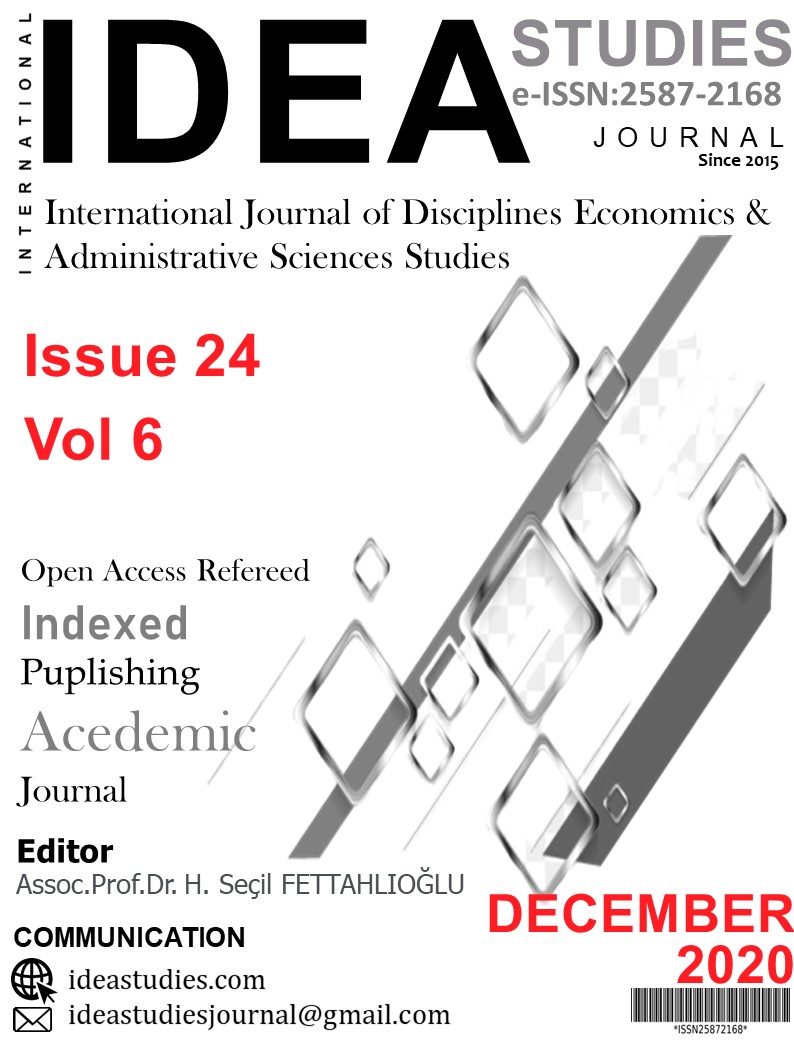Author :
Abstract
Ülkelerin öncelikli hedefleri arasında yer alan ekonomik büyümeyi istikrarlı hale getirmek süreklilik açısından oldukça önemlidir. Bu amaçla ülkeler büyümede istikrar sağlayarak sürekliliği devam ettirebilmek için dinamik bir süreç içinde değişim ve gelişim yaşamak zorundadır. Teknoloji ile birlikte Ar-Ge harcamalarına ağırlık vermek istikrarlı bir büyüme için değişmez koşuldur. Dolayısı ile teknoloji, inovasyon, ticari marka başvuruları araştırma-geliştirme çalışmalarının ortak bir sonucu olarak ekonomik büyümeye katkı sağlamaktadır. Bu çalışmada ekonomik büyümeye katkısını gözlemleyebilmek açısından seçilmiş OECD ülkelerinin 1996-2017 verileri ile ticari marka başvuruları ve ekonomik büyüme arasındaki ilişki analiz edilmiştir. Analiz sonucuna göre değişkenler arasında pozitif bir ilişkinin varlığı gözlenmiştir. Dolayısı ile ticari markanın büyüme pozitif bir ilişki olduğu sonucuna ulaşılmıştır.
Keywords
Abstract
Stabilizing the economic growth, which is among the priority targets of the countries, is very important for continuity. To this end, countries have to experience change and development in a dynamic process in order to maintain continuity by providing stability in growth. Putting emphasis on R&D expenditures with technology is a constant condition for stable growth. Therefore, technology, innovation, trademark applications contribute to economic growth as a common result of research and development studies. In this study, the relation between 1996-2017 data of selected OECD countries and trademark applications and economic growth was analyzed in order to observe its contribution to economic growth. According to the analysis result, a positive relationship was observed between the variables. Therefore, it is concluded that the trademark has a positive effect on growth.
Keywords
- Ata, A. Y. ve Şahbaz, A. (2013). “Mülkiyet Hakları ile Ekonomik Büyüme Arasındaki İlişki: AB
- Ata, A. Y. ve Şahbaz, A. (2013). “Mülkiyet Hakları ile Ekonomik Büyüme Arasındaki İlişki: AB Ülkeleri Üzerine Ampirik Bir İnceleme”, Sosyoekonomi, 9(20), ss.161–180.
- Baltagi, B. H., (2008), Econometric Analysis of Panel Data, Fourth Edition, West Sussex: John Wiley & Sons.
- Breusch, T.S. ve Pagan, A. R. (1980), “The Lagrange Multiplier Test and its Application to Model Specifications in Econometrics”, Review of Economic Studies, 47, ss.239-53.
- Gülmez, A. ve Akpolat, A.G. (2014). “Ar-Ge & İnovasyon ve Ekonomik Büyüme: Türkiye ve ABÖrneği için Dinamik Panel Veri Analizi’’, AİBÜ Sosyal Bilimler Enstitüsü Dergisi, 14(2), ss. 1-17.
- Işık, C. (2014), “Patent Harcamaları ve İktisadi Büyüme Arasındaki İlişki: Türkiye Örneği”, Sosyoekonomi, 21(21), ss.69-86.
- Işık, N ve Kılınç, E.C. (2016). “İnovasyon-Temelli Ekonomi: Seçilmiş Ülkeler Üzerine Bir Uygulama”,Anadolu Üniversitesi Sosyal Bilimler Dergisi, 16 (1), ss. 13-27.
- Kapetanios, G., Pesaran, M. H., and Yamagata, T. (2011),” Panels with nonstationary multifactorerror structures”, Econometrics, MDPI, 160 (2), pp.326. ff10.1016/j.jeconom.2010.10.001ff. ffhal- 00768190f.
- Karhan, G. ve Çayın, M. (2019). “Mülkiyet Haklarının Ekonomik Büyüme Üzerindeki Rolü:Ampirik Bir Uygulama’’, Gümüşhane Üniversitesi Sosyal Bilimler Enstitüsü Elektronik Dergisi, 10(1), ss.246-253.
- Köse, Z. ve Şentürk, M. (2017). “Ar-Ge- Patent Harcamaları ve Teknolojik İlerlemenin EkonomikBüyüme Üzerindeki Etkisi: Ampirik Bir Uygulama’’, Akademik Araştırmalar ve Çalışmalar Dergisi (AKAD), 9(17), ss.215-221.
- Lewer, J. J. ve Saenz, M. (2005). “Property Rights and Economic Growth: Panel Data Evidence’’, Southwestern Economic Review, 32, ss.157-166.
- Li, J. ve Jiang, Y. (2016). ‘‘Calculation and Empirical Analysis on the Contributions of R&DSpending and Patents to China’s Economic Growth’’. Theoretical Economics Letters, 6(6), 1256- 1266.
- Menyah, K., Nazlıoğlu, Ş. ve Wolde-Rufael, Y., (2014), “Financial Development, Trade Opennessand Economic Growth in African Countries: New Insights from a Panel Causality Approach”, Economic Modelling, 37, ss. 386-394.
- Özcan, S. E. ve Özer, P. (2018). “Ar-Ge Harcamaları ve Patent Başvuru Sayısının EkonomikBüyüme Üzerindeki Etkileri: OECD Ülkeleri Üzerine Bir Uygulama’’, Anadolu Üniversitesi Sosyal Bilimler Dergisi, 18 (1), ss.15-28.
- Parlakyıldız, F. M. ve Güvel, E. A. (2015), “Fikri Mülkiyet Hakları ve Ekonomik BüyümeArasındaki İlişki: G8 Ülkeleri Üzerine Bir Uygulama”, Çukurova Üniversitesi Sosyal Bilimler Enstitüsü Dergisi, 24(2), ss.75-92.
- Pece, A. M., Simona, O. E. O. ve Salisteanu, , F. (2015). “Innovation And Economic Growth: An Empirical Analysis For CEE Countries’’, Procedia Economics and Finance, 26, ss. 461-467.
- Pesaran, M. H. and Yamagata, T. (2008), “Testing slope homogeneity in largepanels”, Econometrics, MDPI, , 142 (1), pp.50. ff10.1016/j.jeconom.2007.05.010ff. ffhal- 00501795f.
- Pesaran, M. H., (2006), “Estimation and inference in large heterogeneous panels with a multifactorerror structure”, CESifo Working Paper, No. 1331, Center for Economic Studies and ifo Institute (CESifo), Munich.
- Peseran, M. H., (2004), “General Diagnostic Tests for Cross Section Dependence in Panels”,University of Cambridge Working Paper, 0435, İnternet Adresi: http://papers.ssrn.com/sol3/papers.cfm?abstract_ id=572504, Erişim Tarihi: 10.09.2019.
- Peseran, M.H., Ullah, A. ve Yamagata, T. (2008), “A Bias-adjusted LM Test of Error Cross-section Independence”, Econometrics Journal, 11, ss.105– 127.
- Samimi, A. J. ve Alerasoul, S. M. (2009). “R&D and Economic Growth: New Evidence from SomeDeveloping Countries’’, Australian Journal of Basic and Applied Sciences, 3(4), ss. 3464- 3469.
- Swamy, P.A.V.B., (1970), “Efficient Inference in Random Coefficient Regression Model”, Econometrica, 38, ss. 311-23.
- Thompson, M. A. ve Rushing, F.W. (1996). ‘‘An Empirical Analysis of the Impact of Patent Protection on Economic Growth’’, Journal of Economic Development, 21(2), ss.61-77.
- Türedi, S. (2016). “The Relationship between R&D Expenditures, Patent Applications and Growth:A Dynamic Panel Causality Analysis for OECD Countries’’, Anadolu University Journal of Social Sciences, 16(1), ss.39- 48.
- Ünlükaplan, İ. ve İnce, C. (2019). “Mülkiyet Hakları ve Ekonomik Büyüme Arasındaki İlişki: ABve OECD Ülkeleri Üzerine Ampirik Bir İnceleme’’, Çukurova Üniversitesi Sosyal Bilimler Enstitüsü Dergisi, 28 (2), ss. 436- 450.
- Westerlund, J. (2007), “Testing for Correction in Panel Data”, Oxford Bulletin of Economics and Statics, Volume 69, Issue 6, December, ss. 709-748.
- (WIPO), (2015), World Intellectual Property Organization, IP Facts and Figures, Geneva: WIPO Publication (No. 943E/15).
- World Development Indicators, (WDI), E.T. 06.05.2020.





